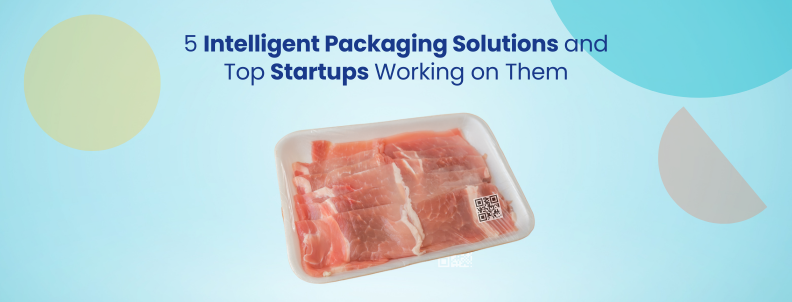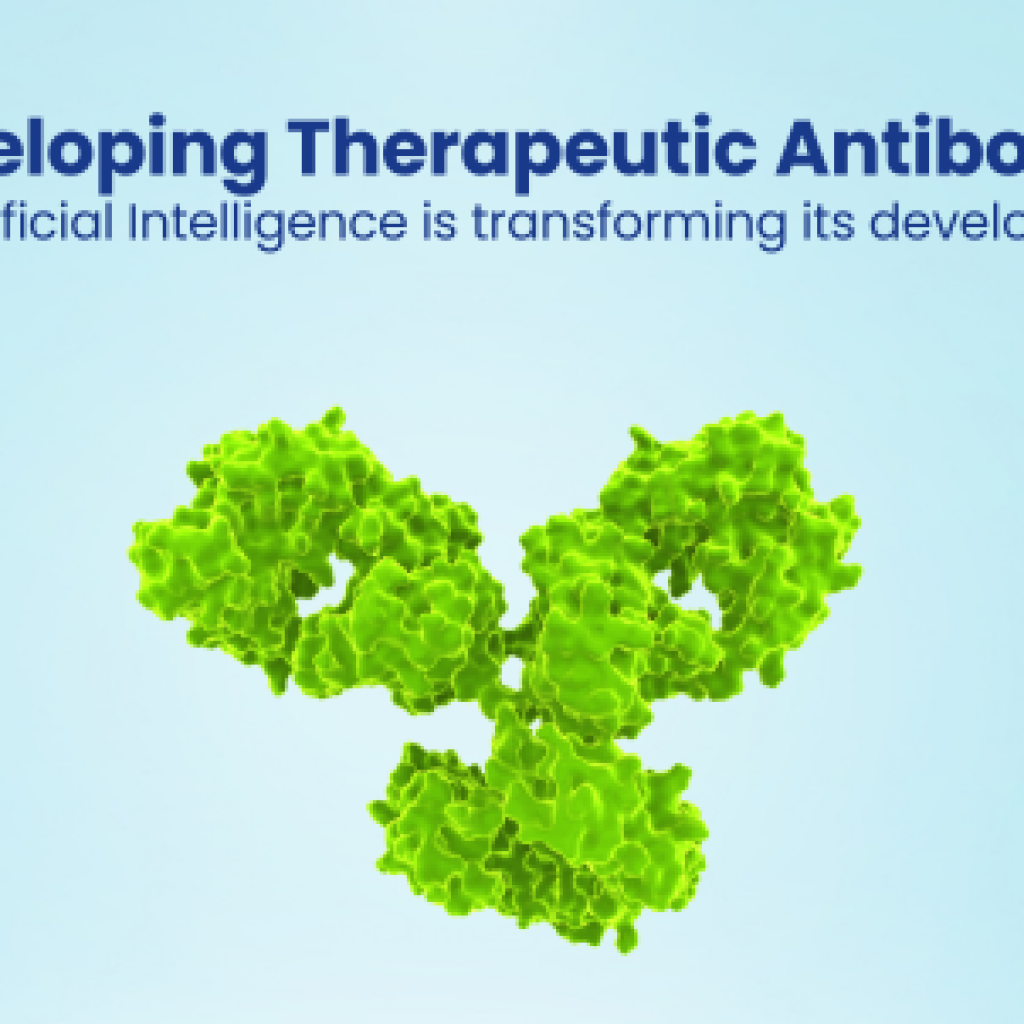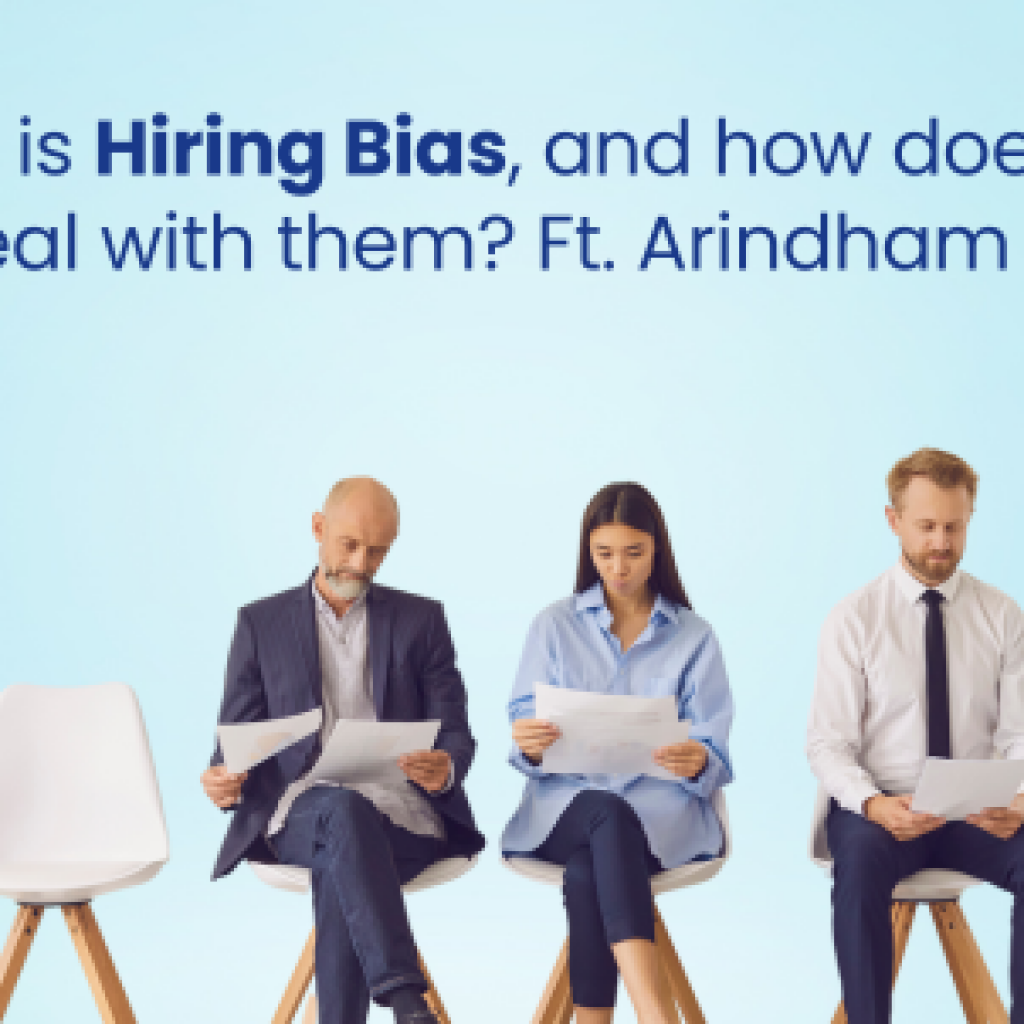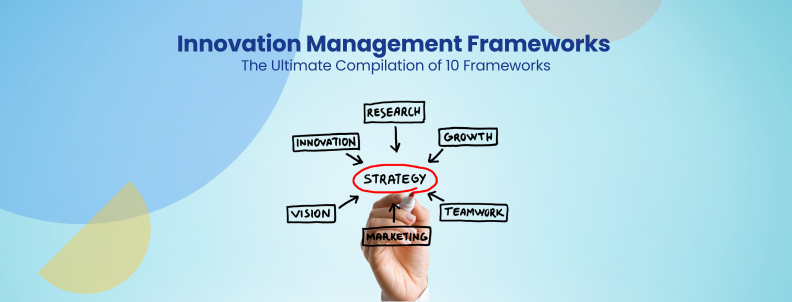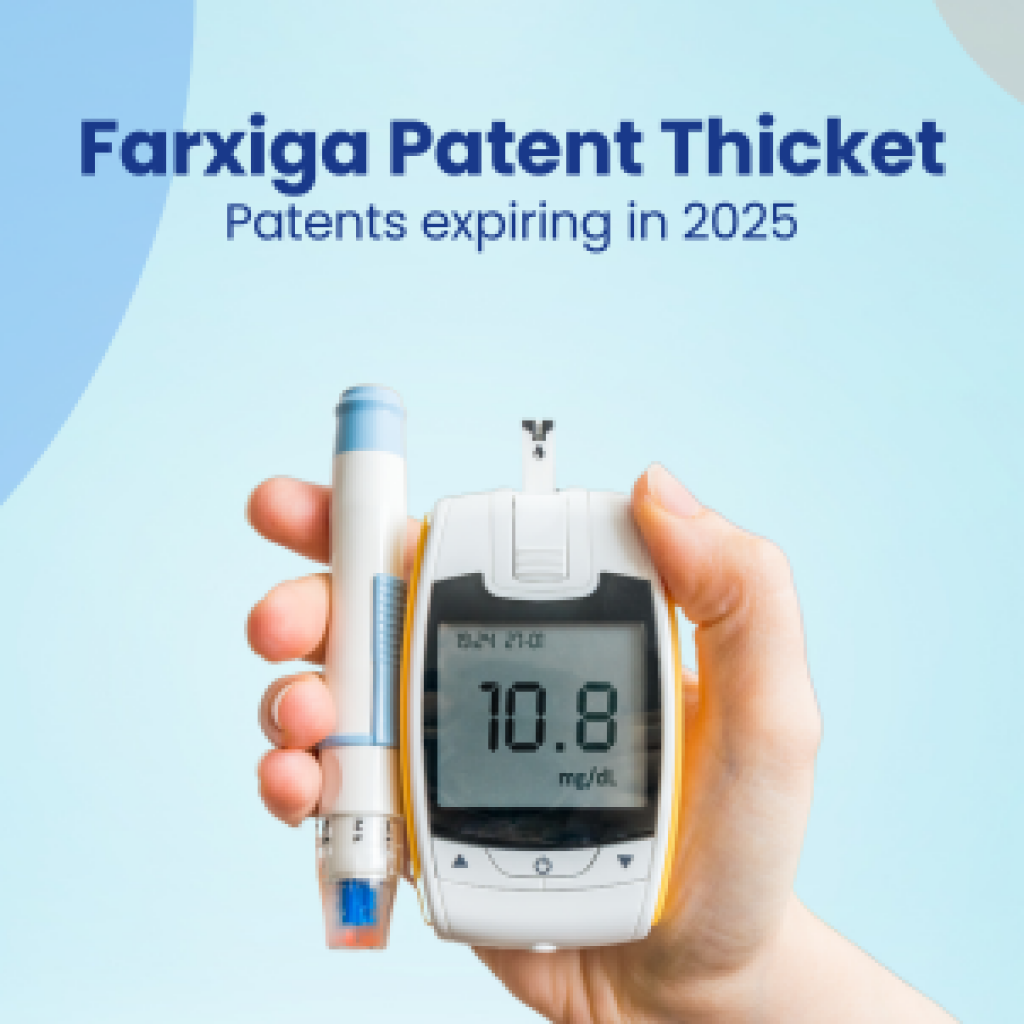Due to rapid urbanization and consumers’ inclination towards individualized personal items, the demand for Intelligent packaging solutions with advanced technologies has increased. This demand is driven by consumers and the need to reduce packaging waste, especially after the COVID-19 pandemic. (Source)
It is essential to keep up with the various forms of intelligent packaging disrupting the industry to stay competitive in the market.
Additionally, you can get our latest packaging trends report (2024) by filling out the form below:
For this article, we will delve into the realm of intelligent packaging solutions, spotlighting the top startups and exploring their multitude of benefits.
1. Smart Packaging
The phrase ‘smart packaging’ refers to a broad umbrella of technology that senses and provides information about the product or brand. Additionally, it increases product and customer safety, monitors freshness, shows quality information, and extends shelf life. Furthermore, recent scientific studies on printed electronics and RFID technology have also contributed to laying the groundwork for developing smart packaging applications.
With such benefits, the global smart packaging market, which was valued at around $37.96 billion in 2021, is expected to grow at a CAGR of 4.5% and reach $49.60 billion by 2027.
Global Smart Packaging Market during 2021-2027 ($Billion)

At the 2019 Active and Intelligent Packaging Association (AIPA) World Congress, Coca-Cola hosted a recycling competition to demonstrate its usefulness. The task was to employ intelligent packaging to motivate people to recycle. Touch code offered a “smart cap” and a connected fridge pack for Coca-Cola’s bottles. Customers could scan both of these with a smartphone to receive details regarding how to recycle the bottle or the location of the closest recycling facility. Additionally, all of these would be printed with invisible conductive ink. (Source)
This was just one example of how smart packaging can be useful. Now, let’s examine why businesses should adopt it immediately.
How does smart packaging benefit businesses?
Allows The Tracking of packages in Real-Time – Real-time tracking includes the package’s location, history, and temperature conditions. Additionally, a web platform allows users to access all information in real-time.
Customer Empowerment – Smart tags embedded in packages collect more information and assist consumers in making informed purchasing decisions. Manufacturers can also use a QR code to inform consumers about nutritional values, origin, dietary issues, etc.
Quality Assurance – Some packaging materials can adapt themselves based on the environment outside and inside the box. Color-changing polymers that detect food spoiling are one of the most significant examples. (Source)(Source)
Increased sustainability – Smart packaging reduces the environmental impact of packaging, giving brands additional sustainable packaging options. Moreover, it has proven affordable and cost-effective, providing businesses a competitive advantage by reducing at source and thereby generating smaller carbon footprints. (Source)
It is clear that smart packaging offers several benefits; therefore, let’s see which startups are working on them now.
Startups working on Smart Packaging
1. LivingPackets (Founding Year – 2016)
LivingPackets is a French company that offers intelligent packaging solutions. Their smart packaging includes-
- Innovative holding mechanisms
- A connected package weighing systems
- Integrated locks to prevent unauthorized opening
- An E-ink display for address reading and updating,
- Expanded polypropylene material and integrated sensors.
Additionally, its software allows for smartphone communication, tracking, and freight monitoring. One of its products, THE BOX, signifies the next generation of smart packaging for the global e-commerce market. Companies like Orange, Cdiscount, and Chronopost have already integrated it into their products. (Source)
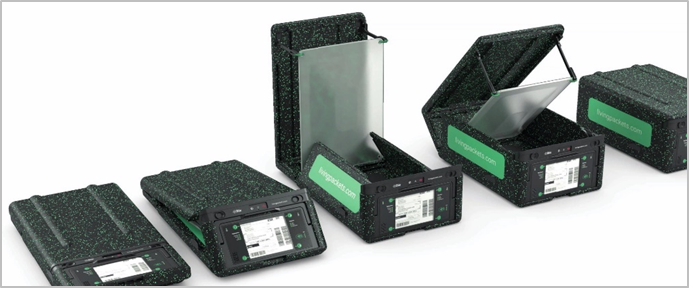
2. Scantrust (Founding Year – 2014)
Scantrust, a Swiss startup, utilizes a unique technology based on naturally occurring deterioration during printing to protect products from unauthorized copying by fusing the adaptability of QR codes with a secure aesthetic. Through their Business Intelligence dashboard, customers can access real-time supply chain data for anything from marketing to logistics.
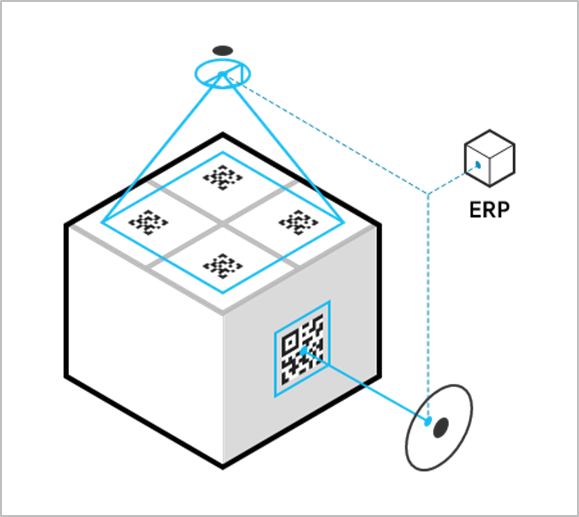
Scantrust used its patented and serialized QR codes to create a customer engagement program. It is used by industry leaders such as Abbott Nutrition, Syngenta, DuPont, LVMH, and many more. Additionally, the company has received two of the three jury awards at the EU Blockathon 2018. (Source)
Scantrust has raised $8.1M in funding over 14 rounds.
2. Digital Print in Packaging
The method of transmitting a digital file straight to a printer for applications on packaging materials is known as digital printing in packaging. Next-generation digital presses and label printers enhance the range of packaging applications, increase productivity, and provide environmental benefits.
Additionally, digital printing is widely used in packaging to produce low-cost samples and models for custom packaging. It may also be used to generate some very eye-catching packaging artwork ideas. Furthermore, digital printing works exceptionally well for minimalist packaging designs because it produces high-quality output for less intricate artwork. Therefore, it’s no wonder its demand has been soaring in the past couple of years. (Source)(Source)(Source)
The global digital printing packaging market was valued at around $22.09 billion in 2021. The market will reach around $50 billion by 2030, growing at a CAGR of 9.5%. (Source)
Global Digital Printing Packaging Market during 2021-2030 ($Billion)
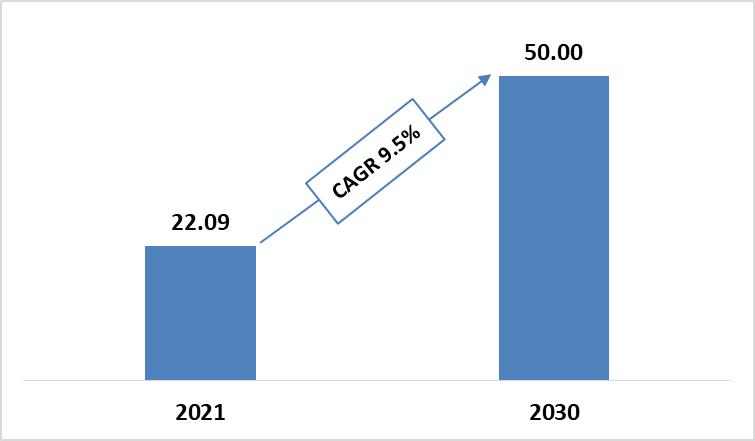
How can Digital Printing Packaging benefit you?
Quick Turnaround Time – Regarding delivery speed, digitally printed packaging delivers a faster production cycle that excites entrepreneurs.
Excellent Color Precision – Digital printing can suit up to 97% of the Pantone color spectrum and enables simple color and property adjustments so that the finished packaging reflects one’s vision. Additionally, printing a short run or small lot of product packaging allows one to test and modify the design and color scheme easily.
Enhanced Brand Protection – Digital print packaging protects a brand by making it difficult to copy specific aspects of the packaging design. Firms are increasingly looking for solutions to secure the authenticity of their products in a world of fake products, and customers want to avoid buying counterfeit. Digital printing inks can produce markings or micro text that are nearly impossible to replicate.
Greater versatility – Business managers often encounter difficulties using conventional print plates with flexible packaging materials. Digital printing is simple to use with hard and flexible materials instead of conventional printing techniques. It can be applied to wood, hard plastic, cotton, metal, and flat cardboard boxes. The transparent films frequently used for packaging fruits and other goods can also be utilized for digital printing. (Source)(Source)
These are all the benefits of digital print in packaging. Now, let’s see which companies are working in this sector.
Companies and Startups working on Digital Print in Packaging
1. CCL Industries (Founding Year – 1951)
CCL Industries Inc. is a Canadian company that creates pressure-sensitive and specialized extruded film materials. These materials have been used by government organizations and multinational clients in consumer packaging, healthcare and chemicals, consumer electronic gadgets, and automotive industries for decorative, educational, utilitarian, and security applications. Using cutting-edge digital printing technology and a wide range of conversion capabilities, CCL Design creates packaging and related products through Late customization and package-level trademark protection. (Source)(Source)
Digital Folded Cartons
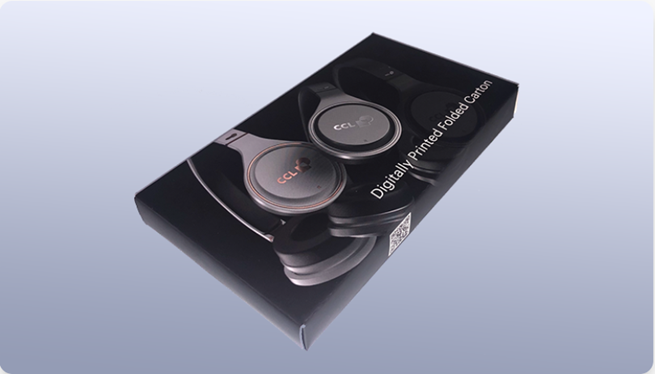
2. Flexible Pack (Founding Year – 2018)
Flexible Pack is a startup established in the United States that provides digital printing for versatile packaging. It prints on adaptable packages, sachets, shrink sleeves, and labels with an HP Indigo digital press. The company aims to quicken the world’s shift to flexible packaging by providing print quality, a broad color range, enhanced efficiency, and high-quality automated finishing. The method also facilitates printing variable data such as barcodes or QR codes. It offers environmentally friendly digital and flexographic printing services to food and beverage, cosmetics, pharmaceuticals, and other industries, which keeps items fresh. (Source)(Source)(Source)
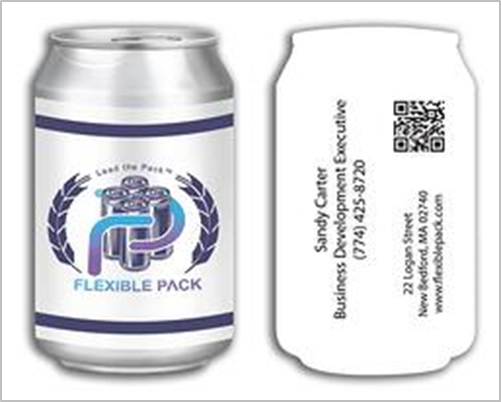
3. 3D Printed Packaging
3D printing is becoming increasingly popular in the packaging sector since it enables businesses to rapidly create a variety of prototypes and reinvent their existing packaging lines. One of the key reasons projected to drive the 3D printed packaging market is the increasing demand and acceptance of packaging goods manufactured using 3D printing technology in the F&B sector.
In addition, considering that no plastic waste is produced during the printing process, it is anticipated that 3D printing will see a rise in popularity and widespread acceptance soon. Moreover, developing countries are making significant investments in expanding their 3D printing packaging manufacturing capacity to meet the growing demand from various sectors worldwide. (Source)(Source)
Therefore, the global 3D printed packaging market, which was valued at around $5.67 billion in 2021, is now expected to reach around $34.87 billion by 2030, growing at a CAGR of 22.4%. (Source)
Global 3D Printed Packaging Market during 2021-2030 ($Billion)
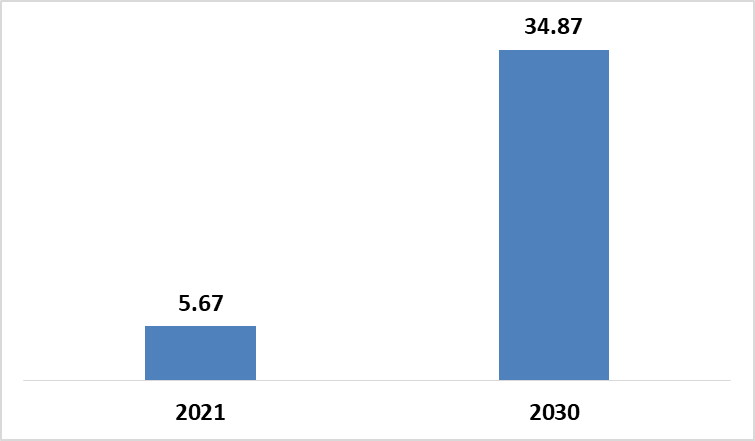
How does 3D-printed packaging help businesses?
Product Prototyping – 3-D printing lets printers make a simple prototype of the final product for packaging concept development from a rapid scan. The generated product prototype helps to visualize, test, and regulate quality. In this way, 3D printing can reduce the time and cost of product development. (Source)(Source)
Environmentally Friendly – 3D printing helps firms produce greener packaging. This method allows plastic waste to be washed, dried, fragmented, and extruded into a printable filament for a new product. 3D printing in packaging may help save the environment as more sustainable bioplastics are utilized. (Source)
Customization – This technology allows companies to provide customized packaging for clients, allowing them to choose a design from an existing range of alternatives or create a unique design from scratch. (Source)
Startups working on 3D Printed Packaging
1. Synteris (Founding Year – 2020)
Synteris, based in the United States, employs 3D printing to make ceramic packaging with one-of-a-kind shapes for power electronic modules. These modules transport energy from a battery to another device, such as a vehicle’s electric motor.
In 2022, it was awarded a grant of $2.7 million from the United States Department of Energy to develop an innovative method of ceramic packaging for electronic components. Additionally, it has also received $150k from the Maryland Innovation Initiative. (Source) (Source)
2. 3D Click (Founding Year – 2016)
3D Click, based in Spain, is an online professional website specializing in 3D packaging. The technology offered by the firm makes it possible for people to immediately personalize packaging in 3D and validate it at the point of sale using augmented reality (AR) and 3D printing. It enables users to design a 3D prototype that is unique to their needs, allowing them to personalize their 3D packing model and share it with other people. (Source)(Source)(Source)


The company has raised $257K to date from three investors.
4. Connected Packaging
Product packaging that supports brand-to-consumer interaction via the Internet and a smartphone is called connected packaging. It concentrates on experience and creativity to give anything from product information to an immersive AR world. QR codes and NFC chips are the most frequently used engagement points in connected packaging, with their applications changing according to industry, product type, and use case.
Since they are widely used in various industries today, their market value has also soared.
The global connected packaging market was valued at around $41.37 billion in 2021. The market will increase and reach around $58.69 billion by 2027, growing at a CAGR of 5.13%. (Source)
Global Connected Packaging Market during 2021-2027 ($Billion)
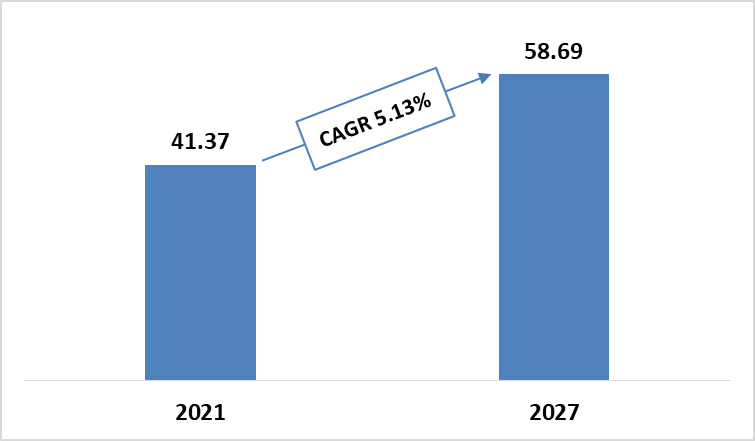
According to the SharpEnd survey, 65% of UK and 74% of US respondents were willing to take the time to figure out how to interact with a product using their smartphone. Customers are keen to participate to gain additional value from their products and packaging, with the top reasons for engaging with experiences such as linked packaging being savings (85% of UK respondents), product instructions (82%), and customer assistance (77%). (Source)
For instance, Yeo Valley employs connected packaging to transmit content and incentivize loyalty with their Yeoken campaign. These could be traded for experiences and prizes aligned with the brand’s values and campaign messaging.
Brands employ connected packaging to provide promotions, offer to collect items and validate the authenticity of a product. Therefore, companies are increasingly interested in connected packaging applications due to their capacity to foster deeper interactions with customers, increasing brand loyalty and customer lifetime value. (Source)(Source)
How does Connected Packaging help Businesses?
Offer Critical Customer Data and Insights – Connected packaging lets firms obtain vital customer information such as demographics and behavior. This information can help brands better understand their customers and meet their demands.
Boost Brand Recognition and Awareness – Connect packaging lets Customers learn more about the products they buy and what the brand stands for. By giving their customers information that they can interact with, such as games or fun augmented reality animations, brands can get closer to their customers. This kind of interaction with customers shows off the brand’s values and promises while making the brand seem friendly and easy to reach.
Increase in Revenue – Connected packaging may potentially increase income for brands who employ it. It contributes to the brand’s image and helps to attract new customers. It can also give a mechanism to boost income from current consumers by offering coupons, discounts, and vouchers to stimulate repeat purchases. (Source)(Source)
We know the benefits of connected packaging; now, let’s see the startups working on them.
Startups working on Connected Packaging
1. ColorSensing (Founding Year – 2018)
ColorSensing is a Spanish startup that uses Connected QR technology to determine food quality automatically and statistically. The firm utilizes colorimetry-based detectors to quantify the status of the food within the package, and a color-corrected output indicates the quality of the food.
ColorSensing’s unique algorithm generates ad-hoc color patterns for each application based on QR technology. Any camera can detect this pattern, and the algorithm analyses the photographs containing the pattern, collecting correct information about the ‘real’ colors and delivering either the color-corrected picture or statistical results about the target color to measure, depending on the application. It offers color correction and quantification applications ranging from digital color-analysis sensors to telemedicine picture standards solutions. (Source)(Source)
ColorSensing has raised around € 376K since its inception.

2. Thaddeus (Founding Year – 2015)
Thaddeus is a company established in the United States that develops intelligent packaging for temperature-sensitive objects. The firm’s unique platform, iQ-ler, offers temperature-controlled packaging with a wide range of software and hardware capabilities. Considering greater product safety, the platform features an IoT system that enables real-time tracking, active temperature monitoring, and a lid security sensor.

Medical specimens transported via iQ-ler include vaccines, medicines, blood, tissues, and organs. Moreover, the iQ-ler also stored, transported, and dispensed vaccines, including the first COVID-19 mRNA vaccines, which required a -20°C storage temperature. (Source)(Source)
Thaddeus Medical has raised $881K to date.
5. Active Packaging
Active packaging is not a new concept; the earliest patents trace back to the beginning of the 20th century. However, it is gaining popularity due to material science, biotechnology, and customer expectations. Both corporations and researchers view active packaging as an innovative approach as it is continually covered in the latest scientific journals on developing technologies and advances. (Source)(Source)
Additionally, it has a strong market presence with a good scope for growth.
The global active packaging market was valued at around $23.19 billion in 2021. The market will increase and reach around $31.92 billion by 2026, growing at a CAGR of 6.6%. (Source)
Global Active Packaging Market during 2021-2026 ($Billion)
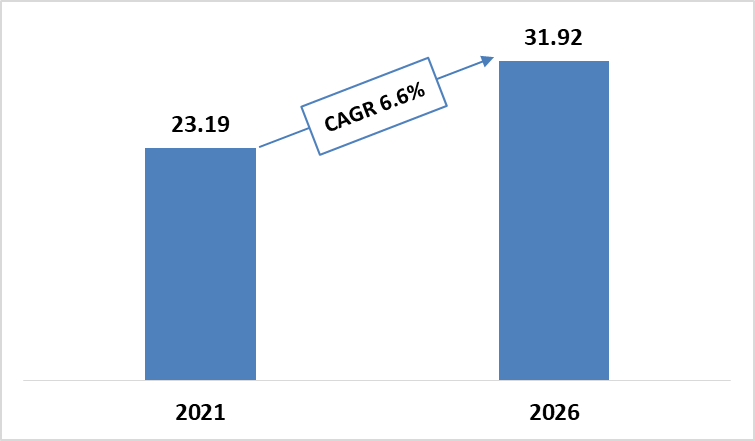
Active Packaging Targets Different Processes and Food Categories
Active packaging uses technology that releases or absorbs substances from food or the headspace of food containers on purpose. This improves the storage life of items by preventing the degradative processes of lipid oxidation, microbial development, and moisture loss and gain. Additionally, advanced versions of active packaging materials release regulated amounts of ethanol into meat and bread goods, which aids in the control of microbial development in certain foods. There are three different types of active packaging depending on the systems used. (Source)(Source)

Active Packaging with Temperature Systems – These devices allow food to be heated or cooled, as well as systems that can raise the temperature within the container. This is the case with the VSteam bag, which enables the food to be cooked and consumed while still in the bag.
Active Packaging with Absorber and Emitter Systems – The absorbers remove undesirable elements such as oxygen, ethylene, excess moisture, and specific tastes and odors. Emitters, on the other hand, produce antimicrobial substances such as carbon dioxide and ethanol.
Active Packaging with Systems That Alter or Interact with the Food’s Composition – Various natural extracts are added to packaging materials that might be anti-microbial, taste and smell absorbent, enzymatic, or anti-oxidant. (Source)
Advantages of Using Active Packaging
Longer Shelf Life of the Products – Introducing new technologies, such as active packaging, improves the sensory properties of food items and may assure their microbiological safety. Its use reduces food loss and allows for longer transportation and shelf-life.
Improves Microbiological Safety of Food – It utilizes active packaging to identify the presence of ethanol, carbon dioxide, ammonia, sulfur dioxide, hydrogen sulfide, and organic acids or amines. It also recognizes the presence of microbial metabolites. Consequently, ensures or considerably enhances the food’s microbiological and/or microbiological safety.
Enhances Product Sustainability and Minimizes Loss of Money – Active packaging reduces costs by enhancing product sustainability and reducing product wastage. For the food and beverage sector, active packaging solutions are highly technical and often tailored for certain goods. Moreover, food product shelf life is extended through active packaging, which frequently enhances manufacturing efficiency and budgeting. (Source)(Source)(Source)
Next up are the startups working in this sector.
Startups working on Active Packaging
1. SoFresh (Founding Year – 2018)
SoFresh, based in the United States, infuses film containers with natural food-grade extracts to emit active vapor in food.
This packaging material saves food and keeps it from getting moldy as mold spores that absorb the vapor have a far more difficult time surviving since it slows the metabolism. Furthermore, it allows food manufacturers to eliminate preservatives, stop wastage, lower production costs, and provide customers with better quality.
The packaging includes conventional and customized bread and bakery packaging, lid stock materials, overwrap films, and barrier laminations. (Source)

2. Impactful Health R&D (Founding Year – 2017)
Impactful Health R&D, based in Canada, produces sustainable active packaging for fresh fish. The firm provides antibacterial active film technology, which is biodegradable and FDA-compliant for oxygen transmission rate. In addition, it is helpful in applications involving vacuum packaging and maintains the fish’s natural texture. The firm’s innovation extends the fish’s shelf life, thus reducing losses for fish vendors, re-sellers, and aquaculture. (Source)
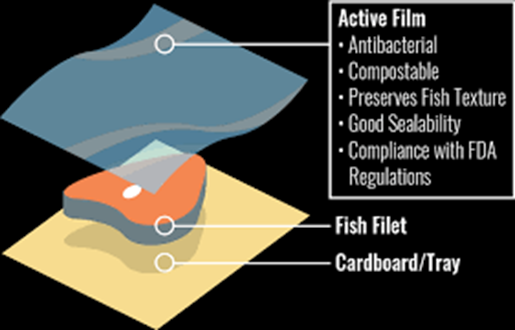
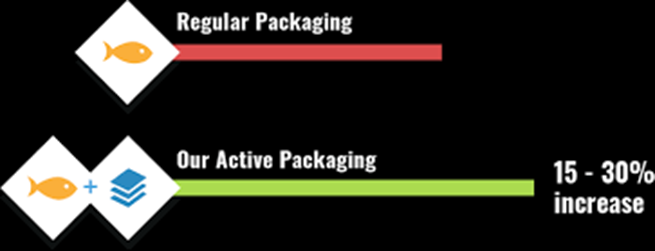
The company has raised $1.8 million to date.
Aptar is a notable mention in this field of packaging. A pioneer in consumer dispensing, active packaging, and medicine delivery systems, it announced the acquisition of FusionPKG in February 2020. FusionPKG is one of the market leaders in premium airless and color cosmetics packaging.
Due to this, Aptar’s Beauty + Home division’s profitability increased as this sector is one of the most important end-user industries in the active packaging market.
Future Outlook
Smart packaging solutions have a promising future, with advancements offering various benefits to consumers and businesses. With the increasing demand for sustainable and eco-friendly packaging, smart solutions that monitor and reduce waste will become more popular. Additionally, integrating technology such as sensors and RFID tags will allow for improved tracking and monitoring of products throughout the supply chain.
Furthermore, smart packaging solutions can also offer personalized recommendations and suggestions based on the user’s preferences and previous interactions. For example, a food product’s packaging could provide recipe ideas, cooking tips, or wine-pairing suggestions through interactive CTAs. This adds value to the consumer and strengthens brand loyalty and customer engagement. Regarding business benefits, smart packaging solutions enable companies to gather valuable data and insights about consumer behavior and preferences. This data can be used to refine marketing strategies, improve product development, and enhance overall customer satisfaction.
All in all, the future of smart packaging solutions will witness disruptive innovation. Technology advancements like augmented reality (AR) and near-field communication (NFC) will provide more immersive and interactive experiences. For instance, AR-enabled innovative packaging could allow consumers to virtually visualize the product or try it out before making a purchase.
The industry of smart packaging solutions is fast evolving, and to stay competitive and keep up with innovation, you need to stay updated with the newest technologies. We understand that it might be daunting to keep up with what’s new in the domain.
Unlock the potential of intelligent packaging innovation effortlessly by clicking the button below.
Authored By: Vipin Singh, Marketing Team
Edited By: Moksha Jain, Marketing Team

